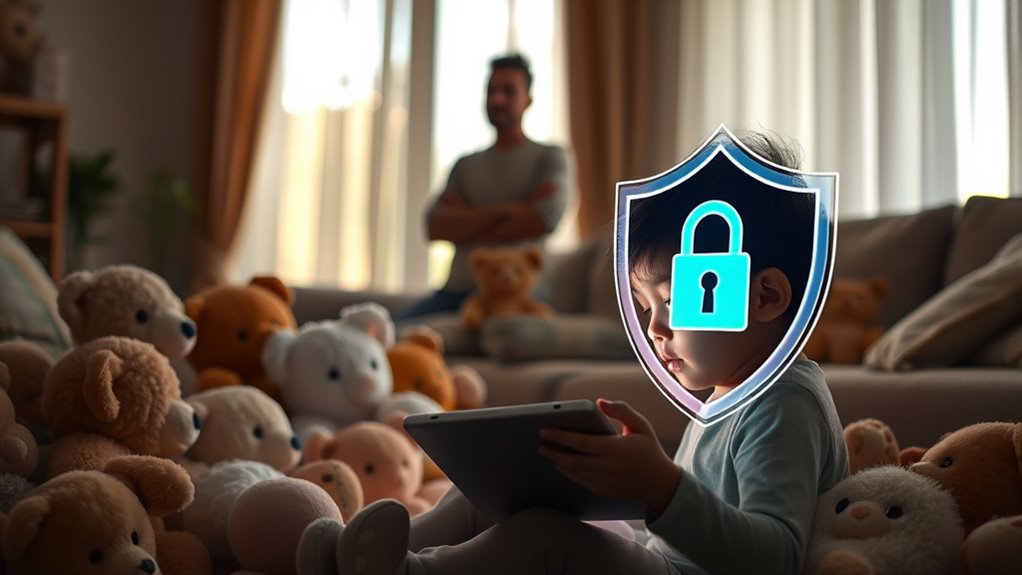To protect your child online, it’s essential to understand internet risks, including cyberbullying and online predators. Encourage open communication about their online experiences and educate them on recognizing inappropriate behavior. Setting clear boundaries and utilizing parental controls can limit harmful exposure. Teaching digital literacy fosters critical thinking and respectful interactions, empowering your child to navigate the online world safely. Discover more strategies to keep your child secure in today’s digital landscape.
Key Takeaways
- Maintain open communication with your child about online threats, fostering trust and encouraging them to report suspicious interactions.
- Implement parental controls and filtering software to limit exposure to inappropriate content and manage screen time effectively.
- Educate your child about privacy settings, secure platforms, and the dangers of sharing personal information online.
- Regularly review and adjust internet safety rules with your child to keep them relevant as they grow.
- Teach children about cyberbullying, identity theft, and respectful online interactions to empower safer digital choices.
Understanding the Risks of Internet Usage

Online predators often exploit anonymity to target children, using social media and gaming platforms to lure them into dangerous situations. It’s vital to communicate openly with your child about these threats, emphasizing their need for caution. The rise of internet scandals has made it increasingly important for children to recognize potential dangers online. This includes understanding the emotional toll of online cheating, which can affect their perceptions of trust and relationships, as well as the importance of open communication when discussing feelings about their online interactions. Additionally, the increasing prevalence of social justice movements highlights the need for children to be aware of the broader implications of their online behavior and how it can impact others.
Furthermore, children may stumble upon inappropriate content, including hate speech and violent imagery, which can negatively impact their behavior and mental health. Implementing filtering software and parental controls can help limit exposure. Regular discussions about internet safety with children can further reinforce the importance of being cautious online. It’s also crucial to help them understand the importance of setting boundaries to protect their emotional well-being.
Finally, educate your child about privacy risks; they might unintentionally share personal information, putting their identity at risk. Awareness and proactive measures are key to ensuring your child’s safety online.
The Impact of Cyberbullying on Children

As children increasingly engage with the digital world, the prevalence of cyberbullying has emerged as a significant concern. About 1 in 5 children faces cyberbullying, with 43% of teens aged 13 to 17 experiencing it in the past year. This harassment can lead to anxiety, depression, and decreased self-esteem, making it crucial to address. Victims often suffer from increased loneliness, declining friendships, and poor academic performance. 1 in 4 children experience bullying particularly highlights the prevalence of this issue. Girls, LGBTQ students, and those from lower-income households are particularly vulnerable. Cyberbullying manifests in various forms, such as spreading false information or sending harassing messages. It’s vital to foster open communication about online safety and be vigilant in monitoring your child’s digital interactions to help mitigate these harmful effects. Additionally, parents should be aware of the emotional neglect that can occur in relationships where bullying is prevalent, as it may further exacerbate the negative impact on a child’s self-worth and identity. Understanding the trust issues that arise from such experiences is essential for effective support and healing. Establishing consistent routines can provide children with the stability they need to cope with the emotional fallout of cyberbullying. Moreover, parents should consider the role of silly tantrums in how children express their emotions online, as these outbursts can indicate deeper issues related to their digital interactions. Encouraging children to develop a growth mindset can empower them to navigate challenges and foster resilience in the face of cyberbullying.
Identifying Online Predators and Prevention Strategies

Cyberbullying isn’t the only danger children face online; online predators pose a significant threat as well.
With around 500,000 predators active daily, they often target kids aged 12 to 15, using fake profiles and manipulative tactics to gain trust. Estimated 500,000 online predators are specifically looking for vulnerabilities in young users to exploit. The emotional and psychological harm caused by these interactions can lead to long-lasting mental health issues for the victims. As with gaslighting tactics, these predators may manipulate children into doubting their instincts and feelings. Children experiencing emotional instability may be particularly vulnerable to these manipulative approaches. Additionally, parents should be aware that alimony laws can impact family dynamics during and after a divorce, which may affect children’s online behavior and emotional well-being. Proper nutrition is also vital, as it supports children’s brain development and can enhance their ability to recognize and respond to online threats.
Watch for warning signs like behavioral changes, increased secrecy, or unexpected gifts. Encourage open conversations about online safety, making sure your child knows to report any suspicious interactions.
Utilize parental controls and privacy settings to monitor their online activities effectively. Teach them about secure platforms and the importance of cybersecurity awareness.
Managing Exposure to Inappropriate Content

While many parents focus on the dangers of online predators, managing exposure to inappropriate content is equally essential for protecting children. Inappropriate content, such as explicit imagery and violent material, can lead to emotional distress and confusion. Emotional healing is important for children who may encounter such content unexpectedly. Additionally, fostering self-care practices can help children process their feelings and seek support when needed. To support their emotional resilience, it can be beneficial to incorporate personalized learning strategies that help children understand and navigate their online experiences better. Development influenced by biological, cognitive, and social factors can shape how children respond to online content and its effects on their well-being. Engaging toys like educational and skill-building toys can also promote healthy emotional development in children.
It’s easily accessible through unfiltered searches and social media, which heightens parental concerns. Some children may inadvertently find inappropriate content due to their curiosity and lack of awareness about online risks.
To combat this, maintain open dialogues with your child about online safety, building trust so they feel comfortable reporting uncomfortable experiences.
Utilize parental controls and safe search tools to filter harmful content, and monitor the websites and apps they use.
Educating your child about online risks empowers them to make safer choices, reducing the likelihood of exposure to inappropriate material.
Protecting Against Identity Theft and Privacy Breaches

In addition to managing inappropriate content, safeguarding your child’s identity and privacy online is essential.
Children are particularly vulnerable to identity theft because they lack credit history, making them attractive targets for thieves. To protect them, consider freezing their credit reports and monitoring for any unexpected inquiries or accounts. This vulnerability arises because cybercriminals target children due to their unblemished credit histories. Furthermore, implementing necessary cookies on devices can help secure their online activities and protect against unauthorized access. Additionally, utilizing strong encryption standards can enhance the security of their online accounts and personal data. Implementing multi-factor authentication can also significantly reduce the risk of unauthorized access to their online accounts. Research shows that adopting AI-driven security measures can further bolster protection against online threats. Establishing a culture of data-driven decision-making in your household about online safety can help reinforce the importance of cautious digital behavior.
Educate your child about the risks of sharing personal information online and guarantee sensitive documents are stored securely. Set privacy settings on social media and warn against using public Wi-Fi.
Encourage your child to accept friend requests only from known contacts and to avoid posting sensitive information. Using tools like parental controls and identity theft services can further enhance your child’s online protection.
Importance of Open Communication With Your Child

Establishing open communication with your child about online safety is essential for fostering trust and ensuring they feel comfortable discussing any concerns.
When you regularly talk about their online experiences, it helps them understand the importance of staying safe. Make these conversations age-appropriate, allowing them to express their feelings about potential threats without fear of judgment.
By actively listening, you can identify issues early and set clear expectations for online behavior. Encourage questions and create a supportive environment where they can safely share their worries.
This openness not only strengthens your relationship but also empowers your child to navigate the internet confidently, reducing risks like cyberbullying and enhancing their critical thinking skills.
Establishing Boundaries for Safe Internet Use

Open communication lays the groundwork for setting boundaries around safe internet use. Start by establishing clear rules that help your child understand online risks and how to mitigate them. Set limits on screen time and specify allowed activities.
Involve your child in creating these rules to foster a sense of responsibility. For younger kids, supervise their internet use closely, while preteens can enjoy more freedom with guidance. As your child matures, adapt rules to include transparency about their online interactions.
Regularly review these boundaries to keep them relevant. Educate your child about online risks like cyberbullying and scams, empowering them to make safer choices. Together, you can create a healthy digital environment that promotes responsible online behavior.
Utilizing Parental Controls Effectively

While traversing the digital landscape, using parental controls effectively can greatly enhance your child’s online safety.
Start by familiarizing yourself with the various tools available, like content restriction and screen time management features. Since 81% of parents use at least one control, you’re not alone in wanting to protect your child.
Familiarize yourself with parental control tools to enhance your child’s online safety and well-being.
Consider device profiling options to tailor access based on your child’s age. Regularly review and adjust the settings to keep pace with their growing needs.
Remember, open communication is key; discussing online safety helps reinforce your control measures. Balancing supervision with guidance is crucial, especially as your child grows.
Promoting Digital Literacy and Online Etiquette

As children navigate the vast digital landscape, promoting digital literacy and online etiquette becomes essential for their development and safety.
You can help your child understand the importance of respectful interactions online. Teach them to think critically about the information they encounter and to practice empathy in their digital communications.
Encourage open discussions about online risks, like cyberbullying and sharing personal information, and set clear rules for internet use.
By integrating digital literacy and etiquette into daily life, you’ll equip your child with the skills they need to thrive in a connected world.
Frequently Asked Questions
What Age Should My Child Start Using Social Media?
When deciding what age your child should start using social media, consider various factors, including their maturity and readiness.
While most platforms require users to be at least 13, many children start around 12. However, waiting until they’re 14 can lead to healthier engagement.
Regularly discuss social media usage with your child, set clear boundaries, and monitor their activity to guarantee a positive experience as they navigate this digital landscape.
How Can I Monitor My Child’s Online Activities Discreetly?
Oh sure, you could just hand your child a smartphone and hope for the best—what could possibly go wrong?
But if you want to monitor their online activities discreetly, try using apps like Bark or Mobicip. They’ll keep tabs without raising suspicion.
Set up network-level controls at home and establish clear rules about online behavior. Open communication’s key too; just remember, you’re not their secret agent!
What Are the Signs My Child Is Being Cyberbullied?
You’ll notice signs your child might be experiencing cyberbullying if they show behavioral changes, like withdrawing from activities they once enjoyed.
Look for increased anxiety, mood swings, or physical complaints such as headaches.
You might see them becoming secretive about their online activities or avoiding certain apps.
Watch for decreased interest in schoolwork or reluctance to socialize, and listen for frequent talks about “drama” or “haters” among their peers.
How Can I Teach My Child About Online Etiquette?
To teach your child about online etiquette, start by discussing the importance of respecting others’ privacy and thinking before they post.
Encourage kindness in their interactions and remind them to use appropriate language.
Model good behavior yourself, and foster open communication so they feel comfortable sharing their online experiences.
Set clear boundaries for their online activity, and emphasize empathy by discussing how their words might affect others.
What Should I Do if My Child Encounters Inappropriate Content?
If your child encounters inappropriate content, instruct them to shut down the device immediately.
Encourage open communication, so they feel comfortable reporting the incident to you. Provide emotional support and discuss what happened, helping them process their feelings.
Use this opportunity to educate them about online risks and appropriate behavior.
Consider implementing parental controls to prevent future exposure, and remind them they can always come to you with any concerns.
Conclusion
In today’s digital world, keeping your child safe online is essential. By fostering open communication and setting clear boundaries, you empower them to navigate the internet wisely. For instance, consider a scenario where your child encounters a suspicious message from a stranger. Instead of panicking, they come to you, having learned to trust your guidance. This trust not only helps them avoid potential dangers but also strengthens your relationship, ensuring they feel safe discussing their online experiences with you.









